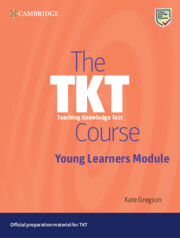Book contents
- Frontmatter
- Acknowledgements
- Contents
- Introduction
- Part 1 Knowledge of young learners and principles of teaching English to young learners
- Part 2 Planning and preparing young learner lessons
- Part 3 Teaching young learners
- Part 4 Assessing young learner learning in the classroom
- Follow-up activities: Answer keys and commentaries
- List of terms found in the TKT Glossary
- Glossary of TKT: Young Learners terms
- Test tips for TKT: Young Learners
- Teaching knowledge test young learners: Practice test
- Sample test answer sheet for TKT: YL practice test
- Answer key for TKT: YL practice test
Reflection on learning in Part 1
Published online by Cambridge University Press: 14 March 2024
- Frontmatter
- Acknowledgements
- Contents
- Introduction
- Part 1 Knowledge of young learners and principles of teaching English to young learners
- Part 2 Planning and preparing young learner lessons
- Part 3 Teaching young learners
- Part 4 Assessing young learner learning in the classroom
- Follow-up activities: Answer keys and commentaries
- List of terms found in the TKT Glossary
- Glossary of TKT: Young Learners terms
- Test tips for TKT: Young Learners
- Teaching knowledge test young learners: Practice test
- Sample test answer sheet for TKT: YL practice test
- Answer key for TKT: YL practice test
Summary
You have come to the end of Part 1. This part of The TKT Course: Young Learner Module aimed to deepen your understanding of the characteristics of children aged 6–12 as learners, and guide you in considering the implications of this for teaching English to these learners. This part of The TKT Course: Young Learner Module also aimed to support your knowledge and skills in preparation for the first part of the TKT: YL Module test: Knowledge of young learners and principles of teaching English to young learners.
Look back to the introduction in Part 1. You assessed your level of understanding before beginning the first unit. Re-assess your understanding in each area.
You also wrote two or three questions or identified areas to find out about in each unit. How well do you think you have achieved these? What can you do to better achieve those areas you need to work on? For example:
Reread a section of the unit(s).
Re-do or do more exploration activities (Second C of each unit).
Discuss the unit(s) content with other teachers in your school or network.
Re-do the TKT: YL practice task(s).
Look in the TKT glossary or the glossary in this book to check meanings of key terms and concepts you are unsure about. Reflect on your classroom teaching more closely.
Look for other readings or resources on the topic(s).
Write yourself two or three objectives for further learning and development in your TKT: YL PD Journal.
■ References and further recommended reading
PART 1 REFERENCES
Cameron, L. (2001). Teaching Languages to Young Learners. Cambridge: Cambridge University Press&Assessment.
Dweck, C.S. (2006). Mindset. Changing the Way You Think to Fulfil Your Potential. London: Robinson.
Ellis, G. and Ibrahim, N. (2015). Teaching Children How to Learn. Peaslake: DELTA Publishing.
Elsworth, S. and Rose, J. (2017) Academy Stars, Pupil's Book 5, p. 34 Oxford: Macmillan Education.
Fisher, R. (2005). Teaching Children to Learn. (2nd ed.) Cheltenham: Nelson Thornes.
Halliwell, S. (1992). Teaching English in the Primary Classroom. Harlow: Longman.
- Type
- Chapter
- Information
- The TKT Course Young Learners Module , pp. 41 - 42Publisher: Cambridge University PressPrint publication year: 2024

